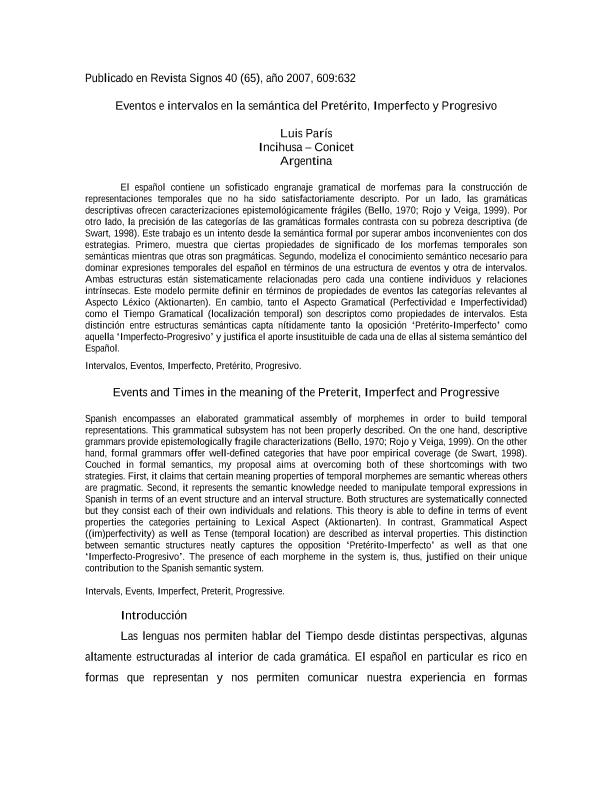Mostrar el registro sencillo del ítem
dc.contributor.author
Paris, Luis Alberto

dc.date.available
2018-03-07T18:19:13Z
dc.date.issued
2007-12
dc.identifier.citation
Paris, Luis Alberto; Eventos e intervalos en la semántica del pretérito, del imperfecto y del progresivo; Pontificia Universidad Católica de Valparaíso, Instituto de Literatura y Ciencias del Lenguaje; Signos; 40; 65; 12-2007; 609-632
dc.identifier.issn
0035-0451
dc.identifier.uri
http://hdl.handle.net/11336/38154
dc.description.abstract
El español contiene un sofisticado engranaje gramatical de morfemas para la construcción de representaciones temporales que no ha sido satisfactoriamente descripto. Por un lado, las gramáticas descriptivas ofrecen caracterizaciones epistemológicamente frágiles (Bello, 1970; Rojo & Veiga, 1999). Por otro lado, la precisión de las categorías de las gramáticas formales contrasta con su pobreza descriptiva (de Swart, 1998). Este trabajo es un intento desde la semántica formal por superar ambos inconvenientes con dos estrategias. Primero, muestra que ciertas propiedades de significado de los morfemas temporales son semánticas mientras que otras son pragmáticas. Segundo, modeliza el conocimiento semántico necesario para dominar expresiones temporales del español en términos de una estructura de eventos y otra de intervalos. Ambas estructuras están sistemáticamente relacionadas pero cada una contiene individuos y relaciones intrínsecas. Este modelo permite definir en términos de propiedades de eventos las categorías relevantes al Aspecto Léxico (Aktionarten). En cambio, tanto el Aspecto Gramatical (perfectividad e imperfectividad) como el Tiempo Gramatical (localización temporal) son descriptos como propiedades de intervalos. Esta distinción entre estructuras semánticas capta nítidamente tanto la oposición ‘pretérito-imperfecto’ como aquella ‘imperfecto-progresivo’ y justifica el aporte insustituible de cada una de ellas al sistema semántico del español.
dc.description.abstract
Spanish encompasses an elaborated grammatical assembly of morphemes in order to build temporal representations. This grammatical subsystem has not been properly described. On the one hand, descriptive grammars provide epistemologically fragile characterizations (Bello, 1970; Rojo y Veiga, 1999). On the other hand, formal grammars offer well-defined categories that have poor empirical coverage (de Swart, 1998). Couched in formal semantics, my proposal aims at overcoming both of these shortcomings with two strategies. First, it claims that certain meaning properties of temporal morphemes are semantic whereas others are pragmatic. Second, it represents the semantic knowledge needed to manipulate temporal expressions in Spanish in terms of an event structure and an interval structure. Both structures are systematically connected but they consist each of their own individuals and relations. This theory is able to define in terms of event properties the categories pertaining to Lexical Aspect (Aktionarten). In contrast, Grammatical Aspect ((im)perfectivity) as well as Tense (temporal location) are described as interval properties. This distinction between semantic structures neatly captures the opposition ‘Pretérito-imperfecto’ as well as that one ‘imperfecto-progresivo’. The presence of each morpheme in the system is, thus, justified on their unique contribution to the Spanish semantic system.
dc.format
application/pdf
dc.language.iso
spa
dc.publisher
Pontificia Universidad Católica de Valparaíso, Instituto de Literatura y Ciencias del Lenguaje
dc.rights
info:eu-repo/semantics/openAccess
dc.rights.uri
https://creativecommons.org/licenses/by-nc-sa/2.5/ar/
dc.subject
Intervalos
dc.subject
Eventos
dc.subject
Imperfecto
dc.subject
Pretérito
dc.subject
Events And Times In the Preterit
dc.subject
Imperfect
dc.subject
And Progressive
dc.subject.classification
Estudios Generales del Lenguaje

dc.subject.classification
Lengua y Literatura

dc.subject.classification
HUMANIDADES

dc.title
Eventos e intervalos en la semántica del pretérito, del imperfecto y del progresivo
dc.type
info:eu-repo/semantics/article
dc.type
info:ar-repo/semantics/artículo
dc.type
info:eu-repo/semantics/publishedVersion
dc.date.updated
2017-10-04T17:14:14Z
dc.identifier.eissn
0718-0934
dc.journal.volume
40
dc.journal.number
65
dc.journal.pagination
609-632
dc.journal.pais
Chile

dc.journal.ciudad
Valparaíso, Chile
dc.description.fil
Fil: Paris, Luis Alberto. Consejo Nacional de Investigaciones Científicas y Técnicas. Centro Científico Tecnológico Conicet - Mendoza. Instituto de Ciencias Humanas, Sociales y Ambientales; Argentina
dc.journal.title
Signos
dc.relation.alternativeid
info:eu-repo/semantics/altIdentifier/url/https://scielo.conicyt.cl/scielo.php?script=sci_arttext&pid=S0718-09342007000300010&lng=en&nrm=iso&tlng=en
dc.relation.alternativeid
info:eu-repo/semantics/altIdentifier/doi/http://dx.doi.org/10.4067/S0718-09342007000300010
Archivos asociados
